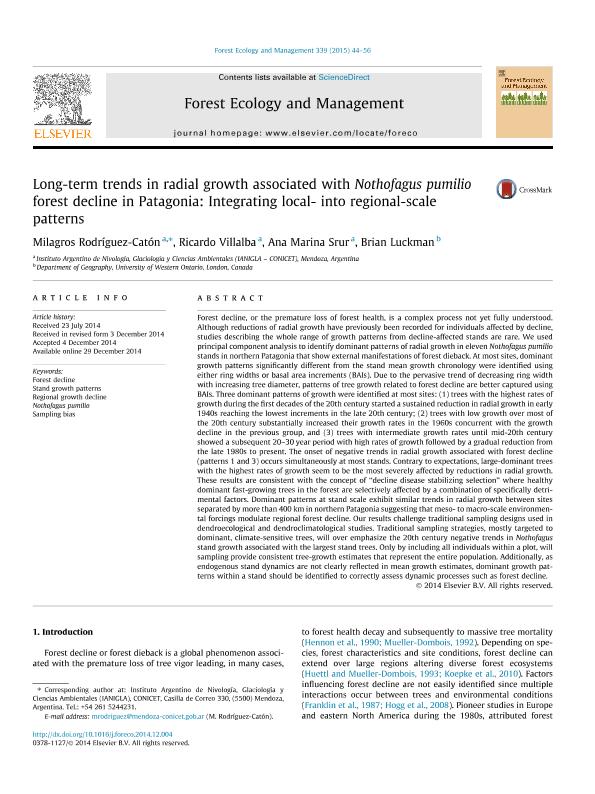Mostrar el registro sencillo del ítem
dc.contributor.author
Rodriguez Catón, Milagros Rocío

dc.contributor.author
Villalba, Ricardo

dc.contributor.author
Srur, Ana Marina

dc.contributor.author
Luckman, Brian
dc.date.available
2018-09-12T16:35:06Z
dc.date.issued
2015-03
dc.identifier.citation
Rodriguez Catón, Milagros Rocío; Villalba, Ricardo; Srur, Ana Marina; Luckman, Brian; Long-term trends in radial growth associated with Nothofagus pumilio forest decline in Patagonia: Integrating local- into regional-scale patterns; Elsevier Science; Forest Ecology and Management; 339; 3-2015; 44-56
dc.identifier.issn
0378-1127
dc.identifier.uri
http://hdl.handle.net/11336/59306
dc.description.abstract
Forest decline, or the premature loss of forest health, is a complex process not yet fully understood. Although reductions of radial growth have previously been recorded for individuals affected by decline, studies describing the whole range of growth patterns from decline-affected stands are rare. We used principal component analysis to identify dominant patterns of radial growth in eleven Nothofagus pumilio stands in northern Patagonia that show external manifestations of forest dieback. At most sites, dominant growth patterns significantly different from the stand mean growth chronology were identified using either ring widths or basal area increments (BAIs). Due to the pervasive trend of decreasing ring width with increasing tree diameter, patterns of tree growth related to forest decline are better captured using BAIs. Three dominant patterns of growth were identified at most sites: (1) trees with the highest rates of growth during the first decades of the 20th century started a sustained reduction in radial growth in early 1940s reaching the lowest increments in the late 20th century; (2) trees with low growth over most of the 20th century substantially increased their growth rates in the 1960s concurrent with the growth decline in the previous group, and (3) trees with intermediate growth rates until mid-20th century showed a subsequent 20-30. year period with high rates of growth followed by a gradual reduction from the late 1980s to present. The onset of negative trends in radial growth associated with forest decline (patterns 1 and 3) occurs simultaneously at most stands. Contrary to expectations, large-dominant trees with the highest rates of growth seem to be the most severely affected by reductions in radial growth. These results are consistent with the concept of "decline disease stabilizing selection" where healthy dominant fast-growing trees in the forest are selectively affected by a combination of specifically detrimental factors. Dominant patterns at stand scale exhibit similar trends in radial growth between sites separated by more than 400. km in northern Patagonia suggesting that meso- to macro-scale environmental forcings modulate regional forest decline. Our results challenge traditional sampling designs used in dendroecological and dendroclimatological studies. Traditional sampling strategies, mostly targeted to dominant, climate-sensitive trees, will over emphasize the 20th century negative trends in Nothofagus stand growth associated with the largest stand trees. Only by including all individuals within a plot, will sampling provide consistent tree-growth estimates that represent the entire population. Additionally, as endogenous stand dynamics are not clearly reflected in mean growth estimates, dominant growth patterns within a stand should be identified to correctly assess dynamic processes such as forest decline.
dc.format
application/pdf
dc.language.iso
eng
dc.publisher
Elsevier Science

dc.rights
info:eu-repo/semantics/openAccess
dc.rights.uri
https://creativecommons.org/licenses/by-nc-sa/2.5/ar/
dc.subject
Forest Decline
dc.subject
Nothofagus Pumilio
dc.subject
Regional Growth Decline
dc.subject
Sampling Bias
dc.subject
Stand Growth Patterns
dc.subject.classification
Otras Ciencias Biológicas

dc.subject.classification
Ciencias Biológicas

dc.subject.classification
CIENCIAS NATURALES Y EXACTAS

dc.title
Long-term trends in radial growth associated with Nothofagus pumilio forest decline in Patagonia: Integrating local- into regional-scale patterns
dc.type
info:eu-repo/semantics/article
dc.type
info:ar-repo/semantics/artículo
dc.type
info:eu-repo/semantics/publishedVersion
dc.date.updated
2018-08-28T19:04:12Z
dc.journal.volume
339
dc.journal.pagination
44-56
dc.journal.pais
Países Bajos

dc.journal.ciudad
Amsterdam
dc.description.fil
Fil: Rodriguez Catón, Milagros Rocío. Consejo Nacional de Investigaciones Científicas y Técnicas. Centro Científico Tecnológico Conicet - Mendoza. Instituto Argentino de Nivología, Glaciología y Ciencias Ambientales. Provincia de Mendoza. Instituto Argentino de Nivología, Glaciología y Ciencias Ambientales. Universidad Nacional de Cuyo. Instituto Argentino de Nivología, Glaciología y Ciencias Ambientales; Argentina
dc.description.fil
Fil: Villalba, Ricardo. Consejo Nacional de Investigaciones Científicas y Técnicas. Centro Científico Tecnológico Conicet - Mendoza. Instituto Argentino de Nivología, Glaciología y Ciencias Ambientales. Provincia de Mendoza. Instituto Argentino de Nivología, Glaciología y Ciencias Ambientales. Universidad Nacional de Cuyo. Instituto Argentino de Nivología, Glaciología y Ciencias Ambientales; Argentina
dc.description.fil
Fil: Srur, Ana Marina. Consejo Nacional de Investigaciones Científicas y Técnicas. Centro Científico Tecnológico Conicet - Mendoza. Instituto Argentino de Nivología, Glaciología y Ciencias Ambientales. Provincia de Mendoza. Instituto Argentino de Nivología, Glaciología y Ciencias Ambientales. Universidad Nacional de Cuyo. Instituto Argentino de Nivología, Glaciología y Ciencias Ambientales; Argentina
dc.description.fil
Fil: Luckman, Brian. University of Western Ontario; Canadá
dc.journal.title
Forest Ecology and Management

dc.relation.alternativeid
info:eu-repo/semantics/altIdentifier/doi/https://dx.doi.org/10.1016/j.foreco.2014.12.004
dc.relation.alternativeid
info:eu-repo/semantics/altIdentifier/url/https://www.sciencedirect.com/science/article/pii/S0378112714007117
Archivos asociados
